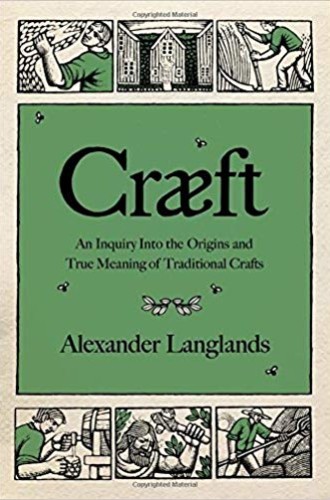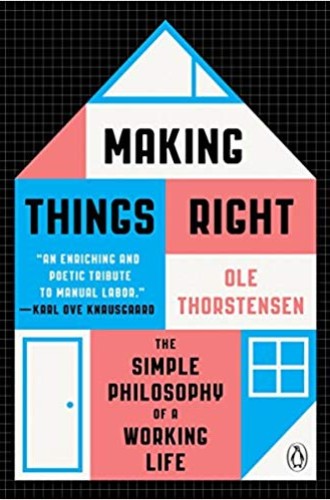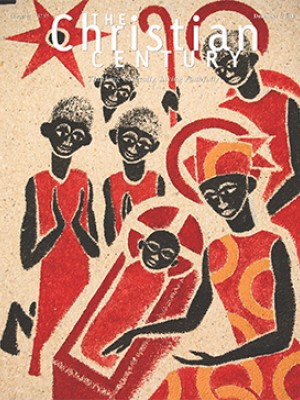Archaeologist and medieval historian Alexander Langlands begins Cræft with a modern technological problem. His strimmer—British parlance for a string trimmer—won’t start. “I always dreaded trying to get the blasted thing started after its long winter hibernation,” he laments. The machine requires so much attention: the right mixture of oil and gas, a fresh air filter and spark plug, and a strong starting cord. If he is lucky enough to awaken the machine from its slumber, then he has to suffer through a “day of monotonous buzzing and rattling, flaying the emerging spring vegetation” that suffocates his wooded cottage.
He finally gives up on the machine and remembers the scythe hanging in his shed. Years earlier, he’d imagined himself “emulating the farmhands of Old England, slashing through acres of luscious meadow grass between manly swigs from a cider flagon.” But he has no idea how to wield the tool. He’s saved by a local man who swings and swipes through the brush with ease. Langlands is impressed and inspired. Although using the scythe is slower than using the strimmer, he writes, “I’d enjoyed listening to the sound of birds while I worked.”
Read our latest issue or browse back issues.
The experience awakens a desire in Langlands, perhaps best known as a regular presenter for the BBC’s Historic Farms series: “I’d taken a traditional way of doing something and had found that, on my terms, it was just as effective as the mechanically charged, petrol-powered methods of today. And so, my relationship with cræft had begun.”
Langlands is not standing athwart innovation; rather, he wants us to rediscover the lost beauty and utility in manual tasks. He wants us to remember the power of our hands. That spirit of rediscovery explains his preference for the Old English word cræft over our modern equivalent. He fears we’ve lost something natural and pure related to cræft, and he finds the origin of our discontent in the Industrial Revolution: “mechanization has changed the way we think, the way we build knowledge; so familiar has postindustrial power become that we genuinely find it hard to relate to the world before it.”
Langlands is a skilled writer—and even better, a lucid storyteller. With just the right amount of etymological explanation and practical examples, he unpacks the evolution of cræft. The result is eye-opening. In the Anglo-Saxon usage of the term, cræft means “power or skill in the context of knowledge, ability and a kind of learning.” It is as much a mental skill, “merit, talent, or excellence,” as it is a physical skill. Unfortunately, modern usage of the world as it relates to mental acumen is more often that of “slyness and cunning,” a devolution that Langlands thinks originates “in the rise of formal knowledge and an emergent snobbery towards manual artisan skill.” Writers, not laborers, “create the texts on which dictionary definitions are founded”—which means Langlands sees his book as an act of repossession, a return to the original meaning of cræft “as a form of knowledge, not just a knowledge of making but a knowledge of being.”
He accomplishes this through telling stories from his own wide-ranging, and sometimes eccentric, experiences. He expands on his early scything anecdote to consider haymaking as cræft, interweaving history with practical notes that feel like they’re from a manual: “Cut too early in the year, for instance, and you run the risk of bringing in an immature crop: thin and innutritious to the animals eating it throughout the winter months.” His haymaking experience leads him to realize that the process requires “an ineffable ability to turn nature’s gifts of sun, wind, rain and the reproductive properties of plants into a source of fuel for livestock.” It’s this kind of writing that truly rehabilitates the meaning of cræft for a contemporary reader sold on a connotation of craft that’s closer to wandering the aisles of a chain store looking for scissors and glue.
My favorite interlude—and probably the most lyrically satisfying stretch of the book—is his chapter on beekeeping. In Britain, by the eighth century, bees were kept in straw basket hives known as skeps. The only materials needed were straw and bramble. The tools were equally simple: “a pocket knife, a small spar hook, a needle made from the leg bone of a goose or turkey, and a sleeve or funnel made from a length of cow horn.”
All of those materials and tools were readily available in pre-Industrial Britain, so when Langlands walks readers through the skep-making process, we feel transported in time. “The making of a skep is an exercise in control and rhythm,” he says, starting a truncated section of the book that is part prose poetry, part philosophy. “At all points the hands must be working to constrain the materials, manipulating them with the end form in mind.” No fan of bees, even I am a bit entranced here. First the straw must be soaked, lightly, to be made “pliable in the hands and forgiving in the twist.” It’s then dressed, and a cow horn is used to funnel the stems together. Ultimately the cane is drawn and stitched until the skep “spirals into life.” Langlands, sounding a lot like Robert Frost defining how a poem happens, says that the shape and form of a skep “are conceived as part of a slow realization rather than an act of preconceived draughtsmanship.” He ends the chapter on a charming note: “The cræft in beekeeping is not in the meddling in the bees’ affairs but in the preparation of their home.”
In addition to his own stories, Langlands shares relevant historical anecdotes. For example, he cites John Ruskin, one of the leaders of the 19th-century Arts and Crafts movement, who was “the first to place an emphasis on the true value in an object or building being derived from the pleasure taken in creating it.” This pleasure, in the theories of Ruskin and Langlands, arises from using as little technology as possible to complete a job. Cræft means being physically deft, strong, and fit, as well as using your mind to understand the materials at your disposal, form “critical decisions about how to approach the work,” and consider “wider financial and time restraints.”
Cræft, then, perfectly describes the project of Norwegian master carpenter Ole Thorstensen. Making Things Right, like Cræft, is a plainspoken book whose lyricism derives from clarity, reflection, and the innate music that comes from methodical descriptions of work. But Thorstensen’s focus is narrower and his narrative more profluent. While Langlands presents a history of cræft filtered through his own experiences, Thorstensen offers a simple tale: a loft renovation.
Both Thorstensen’s prose and his philosophy are wise, blunt, and funny. “I learned the trade as an apprentice,” he explains, “and as a master I learned how to run a business.” On the book’s first page, he warns us: “There is nothing mysterious about skilled manual labor. My job is done to order and is wholly dependent upon demand, upon the instruction of others.” Although the work is not mysterious, Thorstensen is not against finding the poetic in the prosaic. “My tools are an extension of me,” he shares, and “by treating them with care I show respect I have for the profession, the work, and for myself.”
The work of Making Things Right is a loft renovation for the Petersen family, who live in Torshov. Thorstensen gets the call early in the book, and what follows is the methodical documentation of every step in the job: planning, subcontracting painters and electricians and more, acquisition of materials, drafting by an architect, and the inevitable waiting involved in a long-term, complex project. He is a manager even more than a businessman: “In Norwegian culture it is normal for a tradesman in the construction business to have knowledge of an entire job, of his whole field.”
Like Langlands, Thorstensen doesn’t see himself as a grand, legendary laborer. He’s a worker, but what makes his work poetic is that he’s participating in an old tradition. He sees the loft conversion “as taking over and completing work someone else carried out 130 years ago. As though the building phases occur after long intervals yet form part of a coherent process.”
An essential part of Thorstensen’s carpentry work is psychological: understanding the needs and wants of his clients. Much of Langlands’s cræft is solitary, even as he participates in a community, a tradition, of work. In contrast, Thorstensen is working for someone. “Sometimes I have to tease things out of the client, aggravate them almost, pose questions . . . Then I let the questions ferment, and after about a week I pose them anew and get a better answer.” The process helps his clients really figure out what they want. It also helps Thorstensen make sense of his work.
And think about it he does: Thorstensen is clear that there is little boundary between his personal and professional life (although the book is surprisingly quiet on the former). I am reminded of my carpenter father, who tells me how he would not be able to sleep while working on jobs—his mind tethered to plans, cuts, possibilities, anxieties. In these moments, I realize my father was a man of cræft who, like Thorstensen, knows every moment of work is a reflection of himself, his trade, and perhaps something even more. “I would like to be judged on the basis of my profession,” Thorstensen writes, “as though the profession itself is a person.”
Once the bids, plans, and architect’s work has been done—and Thorstensen is pretty critical of that profession—the work begins. Because the loft conversion is a long and complex job, Thorstensen spends most of his days at the house, and it makes for some humorous encounters. The Petersens as have two young boys, and they are curious and excited about their growing house. Each day the builders eat in the kitchen, drink the tap water, and use the bathroom. Thorstensen remembers feeling strange when he first intruded on private lives; even after 25 years, he still brings his own towels to use in the bathroom.
“I am given a glimpse into people’s lives,” he reflects, “whether they are hoarders and what kind of taste they have, or aesthetic sense, as perhaps it is called.” Renovations often require putting things in and out of boxes, and during that work, clients sometimes show him long-forgotten photographs. They tell him stories as they relive the years that have been lost before putting those memories back in the darkness.
The first half of the book is this buildup. It’s a slow drama, but Thorstensen’s insights keep it interesting. When the work actually begins, the book settles into a regular rhythm. Reading Thorstensen’s account of how a loft is built feels like listening to a craftsman tell the story of a job more than being taught how to do it oneself—which is fine, since that bit of mystery feels comforting. We learn what it is like to work as a group, for a long time, on an important and complex project.
He can’t do it himself. He’s a master carpenter, but a home is a labyrinth of skill. Some of the best moments in Making Things Right are when things and people come together. Thorstensen writes:
One of the nicest things I can say about another person is that we have done some heavy lifting together, and I mean that literally. To hold one end of something heavy and be aware of another’s movements, feel them transmitted through the object, is an experience all its own.
The daylight hours are focused and tough, and then it is done. “We unplug our tools, turn the lights off, and leave together, in our work clothes, for the pub.”
Making Things Right gives readers the comforting sense that we are in the hands and mind of someone who has built a life around cræft. “The most important thing experience teaches you,” Thorstensen assures us, “is that you have deficiencies, holes in your knowledge.” Elsewhere he returns to that paradox: “A good professional often has a peculiar mix of confidence and uncertainty. A sort of specialization created by a split personality, as though their confidence depends on their being uncertain. Their desire to avoid mistakes springs from an unceasing stream of questions.”
Langlands would appreciate such care, such reflection, such self-examination of work and creation. Both books remind us: whether we’re using a centuries-old, tried-and-true method to construct a beehive or collaborating to create the best method of ventilation in an attic, cræft is the philosophy that our hands, minds, and selves are the best tools of all.
A version of this article appears in the print edition under the title “The wisdom of making.”







